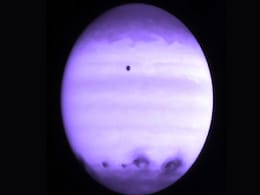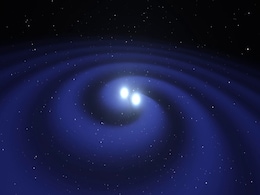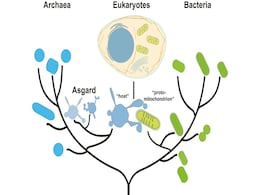Evolution Studies
- All
- News
- Videos
-

Space Research Reveals How Icy Comets and Asteroids Could Reshape Earth-Like Planets
- Saturday May 3, 2025
- Written by Gadgets 360 Staff
New scientific models and telescope observations from 2024 and 2025 reveal how comet and asteroid impacts can change atmospheres on Earth-like exoplanets, potentially supporting life or triggering climate disruption.
-
 www.gadgets360.com
www.gadgets360.com
-

Echidna Species Lived Watery Lifestyles Like Platypuses: Study
- Tuesday April 29, 2025
- Feature | The Conversation
As the world's only surviving egg-laying mammals, Australasia's platypus and four echidna species are among the most extraordinary animals on Earth.
-
 www.ndtv.com
www.ndtv.com
-

Magnetic Fields Could Significantly Influence Oscillations in Merging Neutron Stars, Study Finds
- Saturday April 26, 2025
- Written by Gadgets 360 Staff
Magnetic fields may play a bigger role in neutron star mergers than previously thought. A new study using advanced simulations shows that these fields can shift or suppress oscillation frequencies, altering gravitational wave signatures. This discovery could change how astronomers decode post-merger signals and refine models of neutron star interio...
-
 www.gadgets360.com
www.gadgets360.com
-

Water on Ancient Mars? New Study Challenges the Cold Planet Theory
- Saturday April 26, 2025
- Written by Gadgets 360 Staff
Scientists have uncovered compelling evidence suggesting that early Mars was surprisingly wet, featuring extensive networks of lakes and river basins shaped by rainfall and snowfall. This challenges long-held views of a predominantly cold and icy ancient Mars. Despite current climate models struggling to explain sustained liquid water on the Red Pl...
-
 www.gadgets360.com
www.gadgets360.com
-

Tropical Tree in Panama Evolves Shocking Defense, Strikes Rivals with Lightning Bolts
- Tuesday April 8, 2025
- Written by Gadgets 360 Staff
A few studies describe the tree as having strong internal conductivity, letting lightning current flow through without building up damaging heat like a well-insulated wire. Because they tend to grow large — up to 130 feet (40 meters)—and live for centuries, a single tonka bean tree is estimated to be struck at least five times after reaching ma...
-
 www.gadgets360.com
www.gadgets360.com
-

1 Trillion Species, 3 Billion Years: AI Helped Trace Bacteria Evolution On Earth
- Friday April 4, 2025
- World News | The Conversation
Bacteria consist of a single cell. They do not have bones and are not like big animals that leave clear signs in the geological record, which thankful palaeontologists can study many millions of years later.
-
 www.ndtv.com
www.ndtv.com
-

Two New Exoplanets Found Orbiting a Star in Draco Constellation
- Wednesday April 2, 2025
- Written by Gadgets 360 Staff
Astronomers have identified two exoplanets, TOI-1453 b and TOI-1453 c, orbiting a star 250 light-years away in Draco. The planets, a super-Earth and a sub-Neptune, were detected using NASA’s TESS satellite and the HARPS-N spectrograph. TOI-1453 b is a rocky planet orbiting close to its star, while TOI-1453 c is twice Earth’s size and may have a...
-
 www.gadgets360.com
www.gadgets360.com
-

Asgard Archaea May Hold the Key to the Origins of Eukaryotic Life, New Study Suggests
- Thursday March 27, 2025
- Written by Gadgets 360 Staff
Asgard archaea, a group of single-celled organisms, may hold clues to the evolution of eukaryotic cells. Researchers at ETH Zurich have identified cytoskeletal proteins similar to those in eukaryotes, challenging the traditional three-domain model of life. Their findings suggest these microbes might have enabled key interactions that led to complex...
-
 www.gadgets360.com
www.gadgets360.com
-

Iguanas Travelled 5,000 Miles to Fiji on Rafts 34 Million Years Ago
- Thursday March 20, 2025
- Written by Gadgets 360 Staff
Iguanas undertook a remarkable 5,000-mile journey from North America to Fiji around 34 million years ago. According to a new genetic study, these reptiles floated on rafts of vegetation, possibly due to extreme weather events. The research, published in PNAS, found that Fiji’s iguanas are closely related to North American species, contradicting e...
-
 www.gadgets360.com
www.gadgets360.com
-

Hubble Telescope Captures NGC 4536, a Starburst Galaxy with Intense Star Formation
- Wednesday March 26, 2025
- Written by Gadgets 360 Staff
NASA’s Hubble Space Telescope has captured a striking image of NGC 4536, a starburst galaxy 50 million light-years away in the Virgo constellation. The galaxy’s sweeping spiral arms are filled with young blue star clusters and ionized hydrogen gas, indicating rapid star formation. Astronomers believe its bar-like structure channels gas toward t...
-
 www.gadgets360.com
www.gadgets360.com
-

James Webb Space Telescope Captures Hourglass Nebula LBN 483 in Stunning Detail
- Tuesday March 18, 2025
- Written by Gadgets 360 Staff
The James Webb Space Telescope has captured unprecedented details of LBN 483, a nebula located 650 light-years away. The striking hourglass-shaped structure results from outflows driven by a forming binary star system. JWST’s infrared imaging and ALMA’s radio observations reveal how stellar winds, jets, and magnetic fields sculpt the nebula ove...
-
 www.gadgets360.com
www.gadgets360.com
-

Ancient Europeans Retained Dark Skin, Hair and Eyes Until the Iron Age, Claims New Study
- Monday March 17, 2025
- Written by Gadgets 360 Staff
A genetic study analysing 348 ancient DNA samples reveals that most prehistoric Europeans had dark skin, hair, and eyes well into the Iron Age. Although genes for lighter pigmentation appeared around 14,000 years ago, they remained rare until about 3,000 years ago. Lighter skin may have been advantageous for vitamin D production, while lighter eyes...
-
 www.gadgets360.com
www.gadgets360.com
-

Smallest Galaxy Ever Found: Andromeda XXXV Defies Cosmic Evolution Models
- Thursday March 13, 2025
- Written by Gadgets 360 Staff
Astronomers have discovered Andromeda XXXV, the smallest and faintest known galaxy, located 3 million light-years away. It challenges existing models of galaxy formation, as similar small galaxies were thought to be destroyed in the early universe. Researchers are studying how it retained conditions for star formation despite harsh cosmic environme...
-
 www.gadgets360.com
www.gadgets360.com
-

Black Hole Singularities May Not Exist, Say Scientists
- Friday March 7, 2025
- Written by Gadgets 360 Staff
A new study questions the existence of black hole singularities, suggesting refinements to Einstein’s equations using quantum gravity concepts. Researchers argue that infinite density points may not be real, replacing them with highly curved but finite regions of space-time. While direct observation remains difficult, gravitational waves and earl...
-
 www.gadgets360.com
www.gadgets360.com
-

Neanderthal Genetic Bottleneck 110,000 Years Ago May Explain Their Decline
- Wednesday March 5, 2025
- Written by Gadgets 360 Staff
A study suggests that Neanderthals experienced a population bottleneck 110,000 years ago, drastically reducing their genetic diversity. CT scans of their inner ear bones revealed a sharp decline in variation, indicating a drop in population size. This event may have made Neanderthals more vulnerable to environmental and competitive pressures, contr...
-
 www.gadgets360.com
www.gadgets360.com
-

Space Research Reveals How Icy Comets and Asteroids Could Reshape Earth-Like Planets
- Saturday May 3, 2025
- Written by Gadgets 360 Staff
New scientific models and telescope observations from 2024 and 2025 reveal how comet and asteroid impacts can change atmospheres on Earth-like exoplanets, potentially supporting life or triggering climate disruption.
-
 www.gadgets360.com
www.gadgets360.com
-

Echidna Species Lived Watery Lifestyles Like Platypuses: Study
- Tuesday April 29, 2025
- Feature | The Conversation
As the world's only surviving egg-laying mammals, Australasia's platypus and four echidna species are among the most extraordinary animals on Earth.
-
 www.ndtv.com
www.ndtv.com
-

Magnetic Fields Could Significantly Influence Oscillations in Merging Neutron Stars, Study Finds
- Saturday April 26, 2025
- Written by Gadgets 360 Staff
Magnetic fields may play a bigger role in neutron star mergers than previously thought. A new study using advanced simulations shows that these fields can shift or suppress oscillation frequencies, altering gravitational wave signatures. This discovery could change how astronomers decode post-merger signals and refine models of neutron star interio...
-
 www.gadgets360.com
www.gadgets360.com
-

Water on Ancient Mars? New Study Challenges the Cold Planet Theory
- Saturday April 26, 2025
- Written by Gadgets 360 Staff
Scientists have uncovered compelling evidence suggesting that early Mars was surprisingly wet, featuring extensive networks of lakes and river basins shaped by rainfall and snowfall. This challenges long-held views of a predominantly cold and icy ancient Mars. Despite current climate models struggling to explain sustained liquid water on the Red Pl...
-
 www.gadgets360.com
www.gadgets360.com
-

Tropical Tree in Panama Evolves Shocking Defense, Strikes Rivals with Lightning Bolts
- Tuesday April 8, 2025
- Written by Gadgets 360 Staff
A few studies describe the tree as having strong internal conductivity, letting lightning current flow through without building up damaging heat like a well-insulated wire. Because they tend to grow large — up to 130 feet (40 meters)—and live for centuries, a single tonka bean tree is estimated to be struck at least five times after reaching ma...
-
 www.gadgets360.com
www.gadgets360.com
-

1 Trillion Species, 3 Billion Years: AI Helped Trace Bacteria Evolution On Earth
- Friday April 4, 2025
- World News | The Conversation
Bacteria consist of a single cell. They do not have bones and are not like big animals that leave clear signs in the geological record, which thankful palaeontologists can study many millions of years later.
-
 www.ndtv.com
www.ndtv.com
-

Two New Exoplanets Found Orbiting a Star in Draco Constellation
- Wednesday April 2, 2025
- Written by Gadgets 360 Staff
Astronomers have identified two exoplanets, TOI-1453 b and TOI-1453 c, orbiting a star 250 light-years away in Draco. The planets, a super-Earth and a sub-Neptune, were detected using NASA’s TESS satellite and the HARPS-N spectrograph. TOI-1453 b is a rocky planet orbiting close to its star, while TOI-1453 c is twice Earth’s size and may have a...
-
 www.gadgets360.com
www.gadgets360.com
-

Asgard Archaea May Hold the Key to the Origins of Eukaryotic Life, New Study Suggests
- Thursday March 27, 2025
- Written by Gadgets 360 Staff
Asgard archaea, a group of single-celled organisms, may hold clues to the evolution of eukaryotic cells. Researchers at ETH Zurich have identified cytoskeletal proteins similar to those in eukaryotes, challenging the traditional three-domain model of life. Their findings suggest these microbes might have enabled key interactions that led to complex...
-
 www.gadgets360.com
www.gadgets360.com
-

Iguanas Travelled 5,000 Miles to Fiji on Rafts 34 Million Years Ago
- Thursday March 20, 2025
- Written by Gadgets 360 Staff
Iguanas undertook a remarkable 5,000-mile journey from North America to Fiji around 34 million years ago. According to a new genetic study, these reptiles floated on rafts of vegetation, possibly due to extreme weather events. The research, published in PNAS, found that Fiji’s iguanas are closely related to North American species, contradicting e...
-
 www.gadgets360.com
www.gadgets360.com
-

Hubble Telescope Captures NGC 4536, a Starburst Galaxy with Intense Star Formation
- Wednesday March 26, 2025
- Written by Gadgets 360 Staff
NASA’s Hubble Space Telescope has captured a striking image of NGC 4536, a starburst galaxy 50 million light-years away in the Virgo constellation. The galaxy’s sweeping spiral arms are filled with young blue star clusters and ionized hydrogen gas, indicating rapid star formation. Astronomers believe its bar-like structure channels gas toward t...
-
 www.gadgets360.com
www.gadgets360.com
-

James Webb Space Telescope Captures Hourglass Nebula LBN 483 in Stunning Detail
- Tuesday March 18, 2025
- Written by Gadgets 360 Staff
The James Webb Space Telescope has captured unprecedented details of LBN 483, a nebula located 650 light-years away. The striking hourglass-shaped structure results from outflows driven by a forming binary star system. JWST’s infrared imaging and ALMA’s radio observations reveal how stellar winds, jets, and magnetic fields sculpt the nebula ove...
-
 www.gadgets360.com
www.gadgets360.com
-

Ancient Europeans Retained Dark Skin, Hair and Eyes Until the Iron Age, Claims New Study
- Monday March 17, 2025
- Written by Gadgets 360 Staff
A genetic study analysing 348 ancient DNA samples reveals that most prehistoric Europeans had dark skin, hair, and eyes well into the Iron Age. Although genes for lighter pigmentation appeared around 14,000 years ago, they remained rare until about 3,000 years ago. Lighter skin may have been advantageous for vitamin D production, while lighter eyes...
-
 www.gadgets360.com
www.gadgets360.com
-

Smallest Galaxy Ever Found: Andromeda XXXV Defies Cosmic Evolution Models
- Thursday March 13, 2025
- Written by Gadgets 360 Staff
Astronomers have discovered Andromeda XXXV, the smallest and faintest known galaxy, located 3 million light-years away. It challenges existing models of galaxy formation, as similar small galaxies were thought to be destroyed in the early universe. Researchers are studying how it retained conditions for star formation despite harsh cosmic environme...
-
 www.gadgets360.com
www.gadgets360.com
-

Black Hole Singularities May Not Exist, Say Scientists
- Friday March 7, 2025
- Written by Gadgets 360 Staff
A new study questions the existence of black hole singularities, suggesting refinements to Einstein’s equations using quantum gravity concepts. Researchers argue that infinite density points may not be real, replacing them with highly curved but finite regions of space-time. While direct observation remains difficult, gravitational waves and earl...
-
 www.gadgets360.com
www.gadgets360.com
-

Neanderthal Genetic Bottleneck 110,000 Years Ago May Explain Their Decline
- Wednesday March 5, 2025
- Written by Gadgets 360 Staff
A study suggests that Neanderthals experienced a population bottleneck 110,000 years ago, drastically reducing their genetic diversity. CT scans of their inner ear bones revealed a sharp decline in variation, indicating a drop in population size. This event may have made Neanderthals more vulnerable to environmental and competitive pressures, contr...
-
 www.gadgets360.com
www.gadgets360.com

















